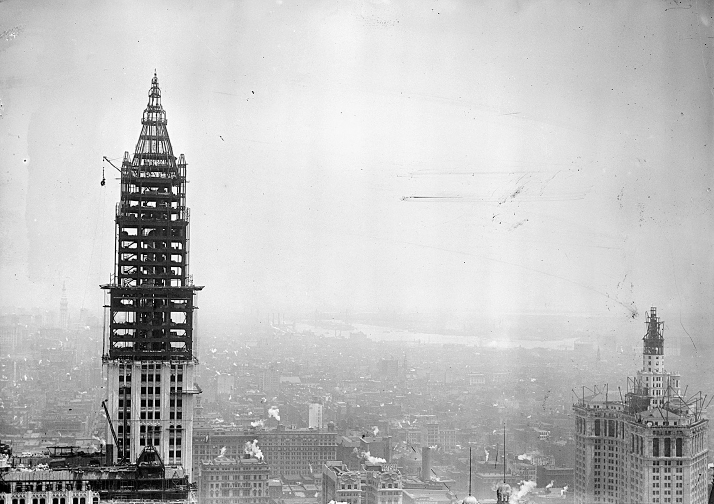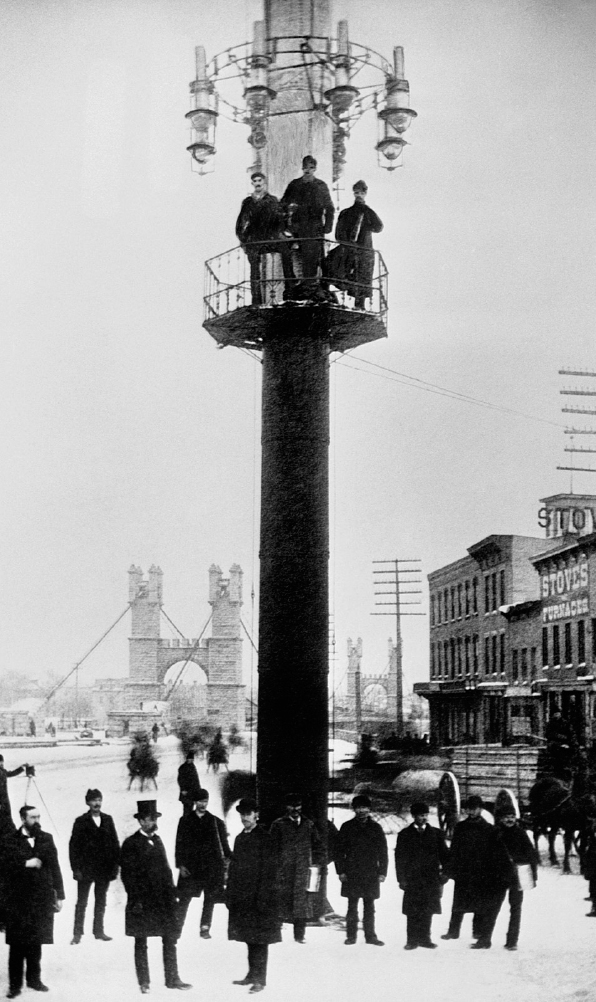America’s History: Printed Page 608
America: A Concise History: Printed Page 553
America’s History: Value Edition: Printed Page 538
The Shape of the Industrial City
Before the Civil War, cities served the needs of commerce and finance, not industry. Early manufacturing sprang up mostly in the countryside, where mill owners could draw water power from streams, find plentiful fuel and raw materials, and recruit workers from farms and villages. The nation’s largest cities were seaports; urban merchants bought and sold goods for distribution into the interior or to global markets.

As industrialization developed, though, cities became sites for manufacturing as well as finance and trade. Steam engines played a central role in this change. With them, mill operators no longer had to depend on less reliable water power. Steam power also vastly increased the scale of industry. A factory employing thousands of workers could instantly create a small city such as Aliquippa, Pennsylvania, which belonged body and soul to the Jones and Laughlin Steel Company. Older commercial cities also industrialized. Warehouse districts converted to small-scale manufacturing. Port cities that served as immigrant gateways offered abundant cheap labor, an essential element in the industrial economy.
Mass Transit New technologies helped residents and visitors negotiate the industrial city. Steam-driven cable cars appeared in the 1870s. By 1887, engineer Frank Sprague designed an electric trolley system for Richmond, Virginia. Electricity from a central generating plant was fed to trolleys through overhead power lines, which each trolley touched with a pole mounted on its roof. Trolleys soon became the primary mode of transportation in most American cities. Congestion and frequent accidents, however, led to demands that trolley lines be moved off streets. The “el” or elevated railroad, which began operation as early as 1871 in New York City, became a safer alternative. Other urban planners built down, not up. Boston opened a short underground line in 1897; by 1904, a subway running the length of Manhattan demonstrated the full potential of high-speed underground trains.
Even before the Civil War, the spread of railroads led to growth of outlying residential districts for the well-to-do. The high cost of transportation effectively segregated these wealthy districts. In the late nineteenth century, the trend accelerated. Businessmen and professionals built homes on large, beautifully landscaped lots in outlying towns such as Riverside, Illinois, and Tuxedo Park, New York. In such places, affluent wives and children enjoyed refuge from the pollution and perceived dangers of the city.
Los Angeles entrepreneur Henry Huntington, nephew of a wealthy Southern Pacific Railroad magnate, helped foster an emerging suburban ideal as he pitched the benefits of southern California sunshine. Huntington invested his family fortune in Los Angeles real estate and transportation. Along his trolley lines, he subdivided property into lots and built rows of bungalows, planting the tidy yards with lush trees and tropical fruits. Middle-class buyers flocked to purchase Huntington’s houses. One exclaimed, “I have apparently found a Paradise on Earth.” Anticipating twentieth-century Americans’ love for affordable single-family homes near large cities, Huntington had begun to invent southern California sprawl.

Skyscrapers By the 1880s, invention of steel girders, durable plate glass, and passenger elevators began to revolutionize urban building methods. Architects invented the skyscraper, a building supported by its steel skeleton. Its walls bore little weight, serving instead as curtains to enclose the structure. Although expensive to build, skyscrapers allowed downtown landowners to profit from small plots of land. By investing in a skyscraper, a landlord could collect rent for ten or even twenty floors of space. Large corporations commissioned these striking designs as symbols of business prowess.
The first skyscraper was William Le Baron Jenney’s ten-story Home Insurance Building (1885) in Chicago. Though unremarkable in appearance — it looked just like other downtown buildings — Jenney’s steel-girder construction inspired the creativity of American architects. A Chicago school sprang up, dedicated to the design of buildings whose form expressed, rather than masked, their structure and function. The presiding genius of this school was architect Louis Sullivan, whose “vertical aesthetic” of set-back windows and strong columns gave skyscrapers a “proud and soaring” presence and offered plentiful natural light for workers inside. Chicago pioneered skyscraper construction, but New York, with its unrelenting demand for prime downtown space, took the lead by the late 1890s. The fifty-five-story Woolworth Building, completed in 1913, marked the beginning of Manhattan’s modern skyline.
The Electric City One of the most dramatic urban amenities was electric light. Gaslight, produced from coal gas, had been used for residential light since the early nineteenth century, but gas lamps were too dim to brighten streets and public spaces. In the 1870s, as generating technology became commercially viable, electricity proved far better. Electric arc lamps, installed in Wanamaker’s department store in Philadelphia in 1878, astonished viewers with their brilliant illumination. Electric streetlights soon replaced gaslights on city streets.
Before it had a significant effect on industry, electricity gave the city its modern tempo. It lifted elevators, illuminated department store windows, and above all, turned night into day. Electric streetlights made residents feel safer; as one magazine put it in 1912, “A light is as good as a policeman.” Nightlife became less risky and more appealing. One journalist described Broadway in 1894: “All the shop fronts are lighted, and the entrances to the theaters blaze out on the sidewalk.” At the end of a long working day, city dwellers flocked to this free entertainment. Nothing, declared an observer, matched the “festive panorama” of Broadway “when the lights are on.”
COMPARE AND CONTRAST
Question
How were America’s industrial cities different from the typical city before 1860?